Kona Manta Ray Night Snorkel Kona | Ultimate Guide & Tips
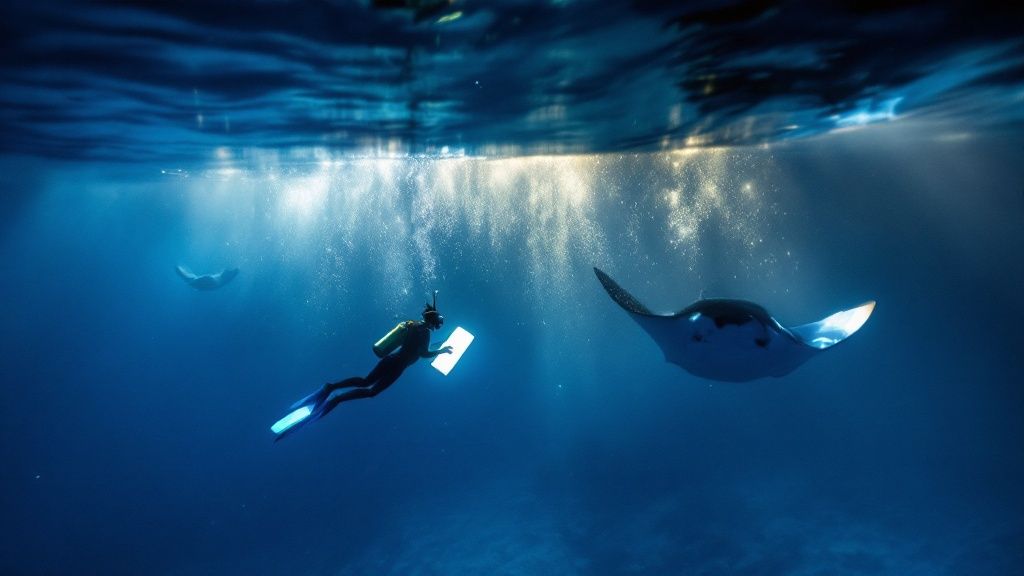
Imagine floating in the quiet, dark Pacific, watching massive, graceful manta rays glide and dance in beams of light just inches below you. The manta ray night snorkel in Kona is hands-down one of Hawaii's most magical wildlife encounters. It’s a front-row seat to a stunning natural spectacle, and this guide will walk you through everything you need to know to plan this incredible adventure.
Discovering One of Hawaii's Top Adventures
The manta ray night snorkel isn't just another tour; it's a genuine experience that consistently lands at the top of every "must-do" list for the Big Island. People fly here from all over the world just to witness this underwater ballet. As Kona Snorkel Trips, the top-rated & most reviewed snorkel company in Hawaii, we have spent years perfecting this adventure to make sure it's safe, respectful, and absolutely breathtaking every single time.
So, what makes this experience so special? It's a perfect storm of unique biology and ideal geography. The Kona coast is a natural feeding ground for a resident population of manta rays. Their nightly pilgrimage to feast on plankton creates a reliable and truly awe-inspiring show for us.
What You Will Experience
On the manta ray night snorkel tour, we'll take you out to a specific viewing area where we shine powerful, eco-friendly lights into the water. These lights attract huge clouds of phytoplankton—the manta rays' favorite meal. Then, the magic happens.
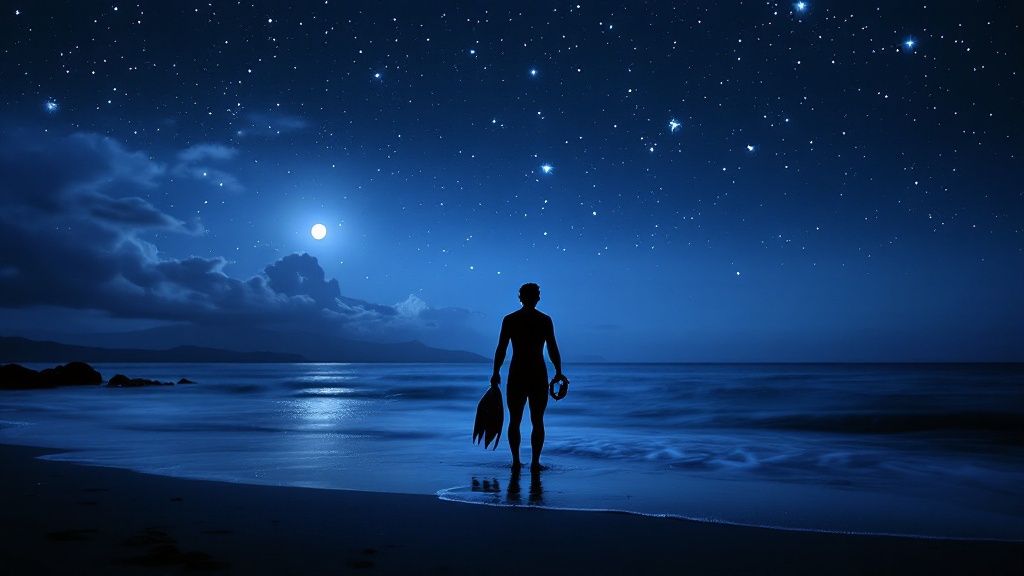
- Gentle Giants Up Close: Manta rays, some with wingspans stretching over 12 feet, appear from the darkness to feed on the plankton.
- An Underwater Ballet: You’ll watch them perform graceful barrel rolls and swoops, gliding effortlessly through the water, sometimes just inches away.
- A Safe and Guided Adventure: You'll hold onto a custom-made light board that keeps you stable and gives you the perfect view, all while our expert guides keep a watchful eye on everything.
This adventure is more than just watching wildlife; it's about being part of a serene, powerful moment in nature. We've designed the whole thing to be accessible even if you've never snorkeled before, making it a perfect trip for families, couples, and solo travelers alike.
There’s really no way to describe the feeling of a giant manta ray gliding silently right beneath you. It’s a humbling, beautiful encounter that connects you directly to the ocean's gentle giants in their own world.
If you're ready to book this amazing manta ray night snorkel in Kona, you can lock in your spot and get ready for an evening you'll never forget.
This guide will cover all the details, from the science behind the spectacle to choosing the right tour and getting ready for your trip. Let's dive in.
Why Kona Is the Manta Ray Capital of the World
So, what’s the deal with Kona? Why is this one specific stretch of coastline on the Big Island the undisputed global hotspot for manta rays? It's not just a lucky accident. It’s this incredible intersection of unique geography, the mantas' biology, and a really special, symbiotic relationship that’s grown between these animals and responsible tourism.
This magical combination is exactly why Kona has earned its title as the place to see manta rays.
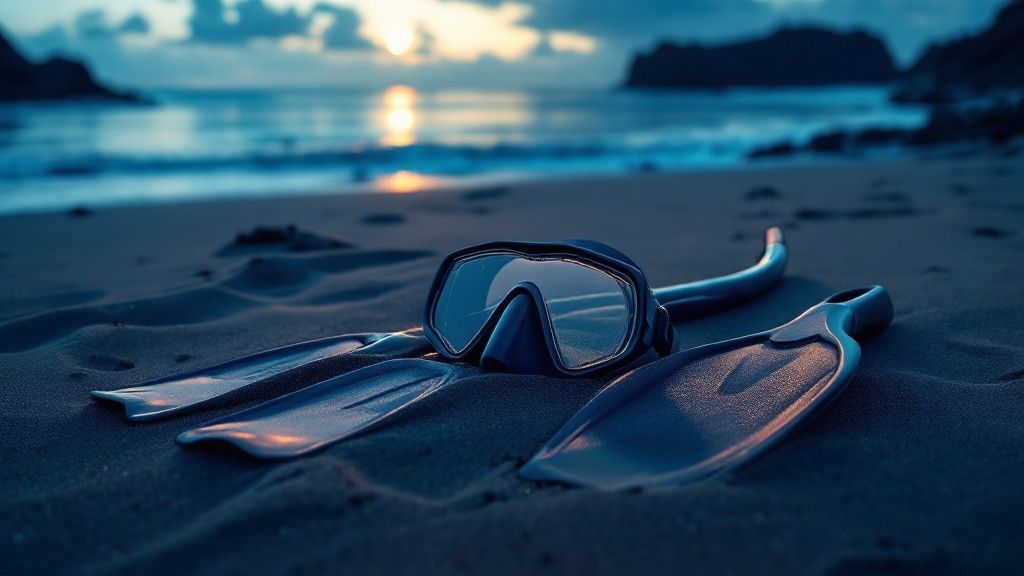
A Natural Phenomenon, Not a Forced Encounter
It’s so important to understand this isn’t an aquarium show or some theme park attraction. The mantas are wild animals, and they show up every night completely on their own terms to feed.
This encounter is a beautiful example of a natural interaction. The mantas are not baited or forced; they simply show up for a reliable nightly buffet, allowing us to be respectful observers of their majestic feeding ritual.
That ethical foundation is what makes this whole experience feel so genuine and profound. You are witnessing a real, wild spectacle in the mantas' own backyard. The tour operators are simply setting the table, using lights to create the conditions for this incredible interaction to happen safely and consistently for both the animals and for us.
The sheer reliability of this natural event is what solidifies Kona's status. It’s the ultimate destination for anyone hoping to witness the breathtaking underwater ballet of the manta ray.
How to Choose Your Manta Ray Snorkel Tour
With so much buzz around Kona’s most famous residents, picking the right manta ray night snorkel kona tour can feel like a pretty big deal. Trust me, not all tours are created equal. The experience you walk away with often boils down to the crew and the boat you choose, so a little homework goes a long way in making sure your adventure is breathtaking, safe, and respectful to the mantas.
Your first big decision is whether to go with a large, amenity-packed vessel or a smaller, more intimate boat. Each offers a totally different vibe. Large boats can feel super stable and spacious. They often have onboard restrooms and snack bars, which can be a huge plus for families with younger kids. The tradeoff? You’re usually sharing the experience with a much larger crowd, which means more people in the water at once.
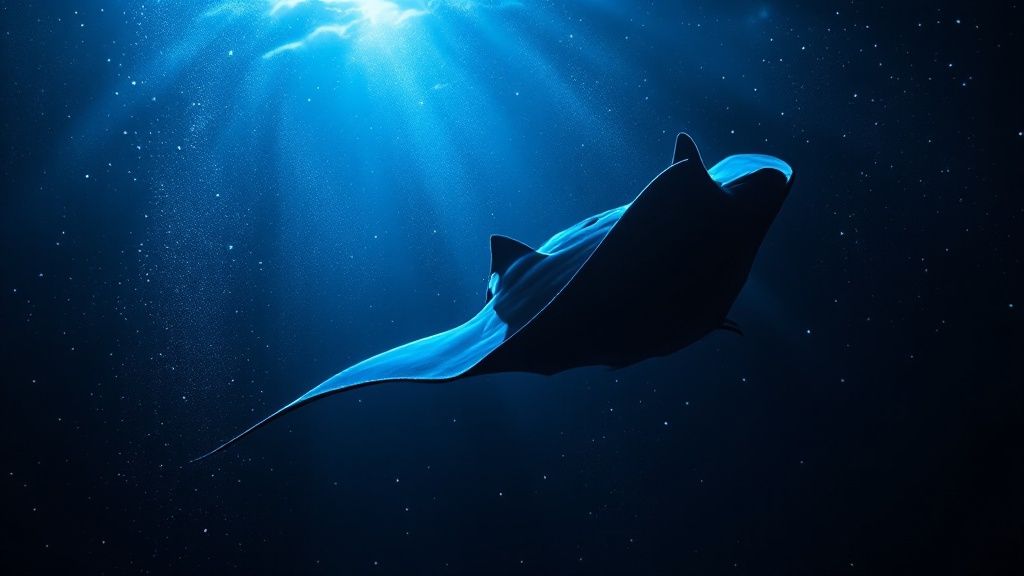
On the flip side, operators like us at Kona Snorkel Trips run smaller vessels. We’re all about a more personal, nimble experience. Smaller groups mean more one-on-one time with your guides and a much less crowded view of the mantas doing their thing. Plus, these boats are often quicker, getting you to the snorkel site faster and giving you more time in the water with these gentle giants. For an exceptional alternative, consider checking out Manta Ray Night Snorkel Hawaii when looking for a Manta Ray night snorkel tour.
Comparing Your Tour Options
Picking the right tour really comes down to what you value most. Are you looking for a cozy, up-close encounter, or do you prefer the stability and features of a bigger boat? To make it easier, here’s a quick breakdown of what you can expect from each.
Manta Ray Tour Operator Comparison
| Feature | Small Boat Tours (e.g., Kona Snorkel Trips) | Large Boat Tours |
|---|---|---|
| Group Size | Intimate, smaller groups (typically 6-20 guests) | Larger crowds that can sometimes exceed 40 guests |
| Experience | Highly personalized attention with less crowding in the water | More onboard amenities like restrooms and snack bars, but can feel less personal |
| Boat Type | Often faster and more agile vessels like Zodiacs or small catamarans | Larger, slower-moving vessels designed for stability with more deck space |
| Best For | Adventurous travelers seeking a personalized and up-close experience | Families with young children or those who prioritize onboard facilities |
So, what's the verdict? If you want to feel like you're on a private expedition with expert guides who know your name, a smaller boat is definitely the way to go. But if the comfort and amenities of a larger vessel are calling to you, that’s a great option, too. The most important thing is finding the perfect fit for your crew.
What to Look for in an Operator
Beyond the size of the boat, a few other things separate a good tour from a great one. Keep these pointers in mind, and you’ll be booking with total confidence.
- Commitment to Safety: This is non-negotiable. A top-notch operator puts safety above everything else. Look for companies with experienced, certified guides who give a thorough safety briefing and use high-quality, well-maintained gear.
- Guide Experience and Knowledge: The best guides aren't just boat captains; they’re passionate marine naturalists. Their knowledge about manta ray behavior, biology, and conservation is what turns a fun activity into an unforgettable educational experience.
- Group Size Management: Even on bigger boats, a good operator will manage how many people are in the water at one time. This ensures everyone stays safe and gets a quality view of the action.
- Eco-Conscious Practices: Responsible tourism is everything. Always choose companies that follow strict guidelines for interacting with marine life. This ensures the mantas are observed respectfully and without being disturbed. You can learn more about what this looks like by checking out our guides to other Big Island snorkeling tours.
By weighing these factors, you can find a tour that perfectly matches what you’re looking for in a responsible and truly amazing wildlife encounter.
What to Expect on Your Manta Ray Adventure
The buzz you feel right before a manta ray night snorkel in Kona is part of the magic. To help you channel that excitement and calm any pre-trip jitters, let's walk through the whole adventure from start to finish. Knowing what’s coming will help you relax and get ready for the show of a lifetime.
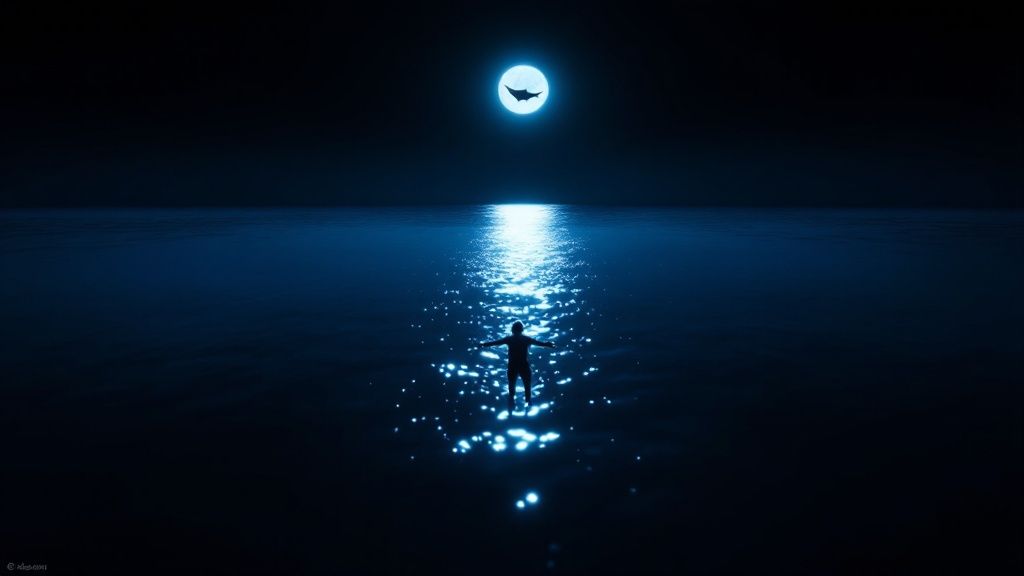
Your evening kicks off late in the afternoon at the harbor. You'll check in with your tour company, meet the crew, and get fitted for all your gear. This includes a wetsuit, which is key to staying warm and comfortable once the sun goes down. It's the perfect time to ask any last-minute questions and chat with the other adventurers on your boat.
The Sunset Boat Ride
Once everyone is suited up, it’s time to board the boat and head for open water. Don't underestimate this part of the trip—it's an experience in itself. As you cruise along the gorgeous Kona coast, the sun starts its slow dip toward the horizon, lighting up the sky in fiery shades of orange, pink, and purple.
During the ride, the crew will give you a detailed safety briefing. They’ll cover everything you need to know:
- How to use your mask and snorkel correctly.
- The ins and outs of the custom light board you'll be holding.
- The most important "rules of engagement" for interacting with mantas, especially the strict no-touching rule.
This briefing is all about making sure everyone feels confident, safe, and ready for what’s ahead. It’s a critical step in making sure the encounter is respectful for the mantas and incredible for everyone involved.
Entering the Water
As twilight fades to dark, you’ll arrive at the viewing site. The crew flips on the powerful underwater lights, which act like a magnet for the plankton that manta rays love to eat. This glowing "campfire" in the ocean sets the stage for the main event. One by one, you’ll slip into the calm, dark water.
That first moment in the ocean at night is surreal. The sounds of the world just melt away, replaced by the soft lap of the waves and the quiet hum of the sea.
The Main Event: An Underwater Ballet
You'll be guided over to a large, floating light board. This clever piece of gear does two things: it gives you something stable to hold onto, and its lights create the "plankton buffet" that brings the mantas right to you. You and the other snorkelers will form a ring around it, floating comfortably on the surface.
And then, you wait. The first time you see a manta ray materialize from the deep blue is a moment you will never forget. These gentle giants, with wingspans that can stretch over 12 feet, glide effortlessly into the light.
It's often described as an underwater ballet. The mantas perform graceful barrel rolls and somersaults, swooping up from below to feed on plankton, sometimes coming within inches of your mask. It is a silent, mesmerizing, and profoundly humbling spectacle.
This incredible natural show is what makes the Big Island a global hub for marine life encounters. Every year, around 80,000 people snorkel or dive with manta rays worldwide, and a huge chunk of that happens right here in Kona. The ability to identify individual mantas by their unique belly spots makes these tours even more special and supports crucial conservation work. You can discover more insights about these remarkable manta ray encounters and the science behind this amazing experience.
After about 45 minutes of pure awe, the guides will help you back on the boat. The crew usually has warm drinks and snacks waiting for the ride back to the harbor—the perfect way to share the buzz of what you just witnessed with your fellow snorkelers under a sky full of stars.
Essential Gear and Safety on the Water
Hopping into the dark Pacific at night might sound a little nerve-wracking, but I promise you, this experience has been perfected over the years to be incredibly safe and welcoming for everyone. Your confidence and comfort are the top priority, so you can just relax and soak in the magic unfolding below.
The key to a great trip is simple: listen to your guides. They’re experts and will give you a full safety rundown before you even get your feet wet, explaining exactly how to use the gear and what to expect. Once you’re in the water, you'll hang onto a custom-built light board. This board isn't just for lighting up the show; it's a stable float that keeps everyone together and gives you something secure to hold onto.
What Your Tour Operator Provides
One of the best things about going with a guided tour is that they handle all the heavy lifting when it comes to gear. No need to lug your own stuff to Hawaii; they've got you covered with high-quality equipment that's cleaned and ready to go.
- Wetsuits: The ocean gets a bit brisk after sunset. A good wetsuit will keep you toasty and comfortable for the entire 45-minute snorkel.
- Mask, Snorkel, and Fins: The crew is great at making sure your gear fits just right. A snug mask means no annoying leaks, just crystal-clear views of the mantas.
- Flotation Support: Not the strongest swimmer? No worries. There are always pool noodles or life vests available to give you a little extra buoyancy and peace of mind.
With all this taken care of, you can just show up ready for an adventure. If you want to feel even more prepared, feel free to brush up on our essential snorkeling safety tips.
Your Manta Ray Snorkel Checklist
While the big stuff is provided, you’ll want to pack a small bag with a few personal items to make your trip as smooth as possible. Here’s a quick checklist to make sure you have everything you need.
| What Tour Companies Provide | What You Should Bring |
|---|---|
| Snorkel Mask and Fins | Swimsuit (wear it under your clothes) |
| Wetsuit (for warmth) | Towel and a dry change of clothes |
| Flotation Devices (if needed) | Reusable Water Bottle |
| Professional Guide and Safety Briefing | Waterproof Camera (GoPro, etc.) |
| Light Board for Viewing | Reef-Safe Sunscreen (for the boat ride) |
To capture the surreal sight of giant mantas gliding just inches beneath you, a waterproof camera is a must. If you're in the market for one, you can explore various action cameras to find a model that works for you. Trust me, you'll want to relive this experience long after you’re back on dry land.
By showing up with these few essentials and putting your trust in the expert crew, you’re all set for a completely stress-free and unforgettable night on the water.
Protecting Kona's Gentle Giants
The manta ray night snorkel in Kona is so much more than just a bucket-list adventure; it's a fragile interaction with a key species in a complex marine ecosystem. As visitors, we all share a responsibility to make sure these encounters are positive for everyone involved—especially the mantas. Being a thoughtful guest is the only way to protect this magical experience for years to come.
The whole foundation of a safe and ethical tour comes down to a few simple but crucial viewing guidelines. These aren't just arbitrary rules; they're designed to protect the health and natural feeding habits of Kona's resident manta population.
Following Manta-Safe Practices
The most important rule is also the easiest to follow: do not touch the manta rays. These gentle giants are covered in a protective mucous coating, which is basically their immune system. It’s a shield against harmful bacteria and infections. Touching them, even with the lightest graze, can strip away this vital layer and leave them vulnerable to disease.
Any good tour operator will drill you on a "passive observation" approach.
- Stay on the Surface: Snorkelers should hang onto the light board and float. This keeps you from accidentally bumping a manta and leaves the water column clear for them to swoop and glide.
- Let Them Approach You: You never, ever chase or swim after a manta ray. The real magic of this experience is that they come to the light on their own terms, often getting breathtakingly close as they feed.
- Minimize Splashing: Try to keep your movements calm and smooth. Big splashes can startle the animals and disrupt their feeding.
When you follow these guidelines, you help create a stress-free buffet for the mantas. Choosing an eco-conscious tour operator is the first and most important step you can take. It’s critical to understand the damage that unregulated tours can cause, a topic we dive into in our article about the dark side of manta ray swims.
More Than a Tour, It's Citizen Science
Believe it or not, your participation in a responsible tour also helps with valuable conservation science. Experienced guides and local researchers can identify hundreds of individual manta rays by the unique spot patterns on their bellies—they’re as distinct as a human fingerprint.
This identification process allows for long-term monitoring of the population's health, growth, and migration patterns. So when your guide points out a familiar manta by name, you're literally witnessing years of dedicated research in action.
By choosing a certified, eco-conscious tour for your manta ray night snorkel in Kona, you're actively supporting the preservation of these magnificent creatures. Your ticket does more than buy an adventure; it’s an investment in the sustainable future of one of the world's most incredible wildlife encounters.
Got a few last-minute questions before you jump in? We hear these all the time. Let's clear them up so you can book your trip with total confidence.
Do I Need to Be a Strong Swimmer?
Not at all. This is one of the biggest misconceptions about the manta snorkel. You're not really "swimming" in the traditional sense.
You'll be holding onto a big, custom-made light board that floats on the surface, which is where all the action is. Think of it like a floating handrail. We also provide extra flotation like pool noodles and life vests, so you can just relax and let the ocean do the work. It’s all about floating and watching the show below.
Is the Manta Ray Night Snorkel Safe?
Absolutely, especially when you go out with a professional, safety-conscious crew. Our guides are experts who live and breathe this stuff. They’ll give you a full safety rundown, get you fitted with top-notch gear, and they’re right there in the water with you the whole time.
And what about the mantas? They're called "gentle giants" for a reason. They are filter feeders, meaning they don't have teeth, stingers, or barbs of any kind. They're just here for the plankton buffet attracted by the lights and are completely harmless to people.
When Is the Best Time of Year to See Mantas in Kona?
This is the best part—anytime is a great time! Kona is blessed with a resident population of manta rays, which means they live here year-round and don't migrate.
They show up to feed at these sites pretty much every single night. That's why sighting rates are consistently over 90%, whether you come in January or July.
The consistency of sightings is what makes Kona the manta ray capital of the world. You can confidently book your trip for any month and have an incredible chance of seeing a spectacular show.
Will I Get Cold Snorkeling at Night?
The water here in Hawaii is beautiful and warm, but hanging out for 45 minutes after sunset can definitely give you a chill. Don't worry, we've got you covered.
Every reputable tour provides quality wetsuits. They work by trapping a thin layer of water between the suit and your skin, which your body quickly heats up. This creates a cozy layer of insulation that keeps you perfectly comfortable, letting you focus on the amazing manta ballet without a single shiver.
Ready to witness the underwater ballet for yourself? Kona Snorkel Trips offers an unforgettable and safe manta ray night snorkel in Kona led by expert guides.
